- The Top 17 Direct Mail Companies - June 11, 2025
- The 11 Best Landing Page Builder Software Tools [2025] - June 11, 2025
- Instapage vs Leadpages vs Unbounce vs Clickfunnels - June 11, 2025
Everlane is one of my favorite startups to follow. They are excellent ecommerce marketers and brand builders.
I’ve watched quite closely over the last five years.
I’ve spoken to employees and investors in the company.
I’ve covered their marketing hacks in bits and pieces in my Ecommerce Marketing Manual and again The Best 10 Ways to Market Your Ecommerce Store.
Everlane: how they went from nothing to $100M+ Revenue
Their value proposition goes something like this:
In traditional retail, a designer shirt is marked up 8x by the time it reaches the customer. At Everlane, we believe customers have the right to know what their products cost to make, so we reveal our true costs, and then show you our markup.
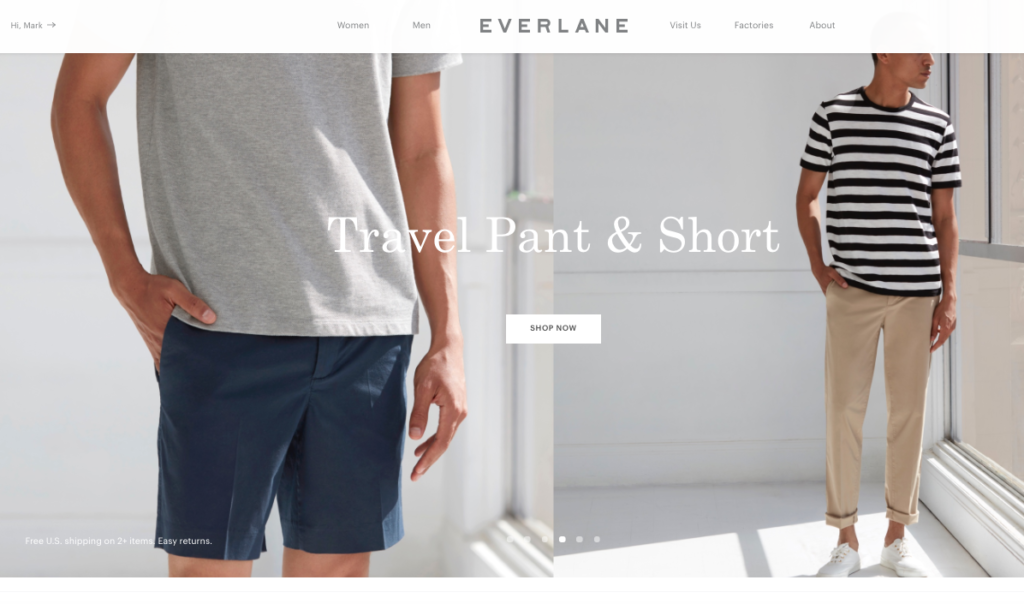
Vertically-integrated ecommerce companies like Everlane have two challenges:
- They need to get customers
- They have to get customers and still stay within the narrow lanes of their very distinct brand.
Everlane has done both things very well.
Everlane ended 2016 with north of $100 million in revenue, more than double the $50 million they booked in 2015. For a company that only sells men’s and women’s apparel basics, it is an incredible success story.
Some of its venture-backed ecommerce peers like Fab.com, One King’s Lane and Gilt experienced meteoric rises and very public declines. Sadly, even older retail stalwarts like Sears are dropping like flies.
Below are the 10 reasons Everlane grew from $0 to $100M+ in revenue in just six years.
Follow in their footsteps and you may just achieve ecommerce nirvana.

By the way: I’m giving away 2 growth hacks you won’t find anywhere else on the internet for FREE!
1. Everlane’s Ecommerce Mission
As with all great companies, Everlane understood an unmet customer need and turned that into their mission to solve.
Solving this customer need is the first reason Everlane has been wildly successful.
Eric Hillern, Brand Strategist at OVO says about Everlane: it is a company who can articulate its value. Which is its essence. And it executes flawlessly.
Clothing is a murky industry. You probably don’t know where your tee shirt was made and you certainly don’t know how much it cost to make. Ralph Lauren, Nike, Adidas and nearly every retailer has been the target of questionable supply chain ethics.
Even more, you probably have no idea why a $50 tee shirt costs 2x more than a $25 tee shirt. Are you paying an upcharge for extra quality?
Founder, Michael Preysman realized that people want transparency in two ways:
1. People want to support a brand that uses ethical labor and
2. They want to know whether they’re being ripped off or not.
“Radical Transparency.” Everlane’s mission is short and understandable – they packaged it up for their customers to hear, easily remember and share.
They elaborate a bit more: “Know your factories. Know your costs. Always ask why.” The mission was crucial to their success.
In fact, the idea was disruptive enough that they were able to raise some venture backing. Without this mission, they were an undifferentiated apparel company.
Everlane wrapped its value proposition in a bow and supports it with a telling infographic on every page.
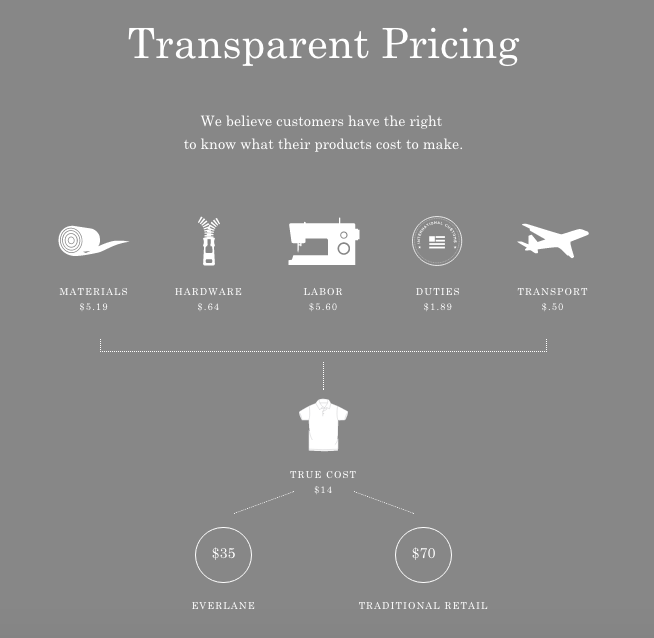
Everlane’s mission is to repair a broken clothing industry with transparency – in pricing and supply chain. Every part of their brand speaks to this this.
There are 110,000+ ecommerce websites in the world. Everlane’s was different enough to get noticed.
Looking for help with your marketing? Work with us at Growth Marketing Pro Agency.
2. The Importance of Focus
Temptation is always around. Startups, particularly venture-backed ones, are often forced to grow unnaturally fast because investors want to see returns.
The normal venture capital fund requires startups to reach “liquidity” within about 12 years. These expectations, while motivating sometimes, can result in lack of clear focus. Chasing revenue can make founders do silly things.
Plenty of companies have stumbled by focusing too broadly. It’s one of the largest killers of startups. Website, OnStartups has a nice article that details the focus phenomenon for software startups: the harsh truth is that broad, flexible, products that can address the needs of many types of users are almost always more expensive to build and maintain than products that only address the needs of a small group of people.
Everlane has been able to focus on its key differentiator – radically transparent apparel – by ignoring distraction.
For over a year, they produced nothing but tee shirts. This gave them the headspace to refine their value proposition, supply chain and customer acquisition playbook.
Below is the 2012 (tee shirt only) version of their website courtesy of Internet Archive’s Wayback Machine (a tool to see what websites once looked like).
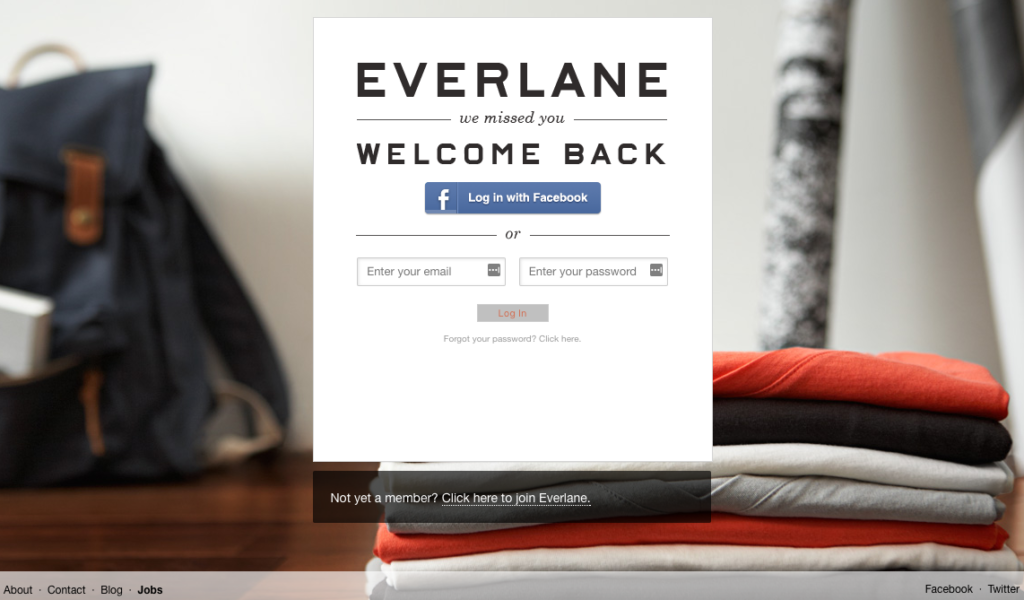
In today’s internet, you cannot afford to be broad. Everlane’s singular focus has allowed them to do the things that matter to their customer: fulfill the mission of “transparent” apparel and make a killer product.
Focus has allowed them to do both of those things admirably.
Plus, doing only one thing reduces the complexity of your business. Lower complexity, usually means lower cost.
Use a keyword research tool like GrowthBar to figure out which products & keywords to focus on by looking at monthly search volume and spying on the competition.
By the way: I’m giving away 2 growth hacks you won’t find anywhere else on the internet for FREE!
3. Everlane’s Focus on Brand
I hate “brand.” Conventionally speaking, brand is not a growth lever, so I tend to stay away from the topic. Plus, I’d argue that focusing too much on brand as a startup is a waste of time. “Brand” will not get you the 2x, 3x or 10x growth you need to get to Series A, $1 million revenue or 100,000 average monthly users.
However, ecommerce companies are a big exception to this rule – brand matters. Look no further than Dollar Shave Club, Harry’s and Warby Parker for evidence of this phenomenon.
The 2012-13 wave of vertically-integrated ecommerce companies (that are beginning to achieve billion+ dollar valuations) were all very brand-centric from day one.
“Brand” is important in ecommerce (particularly in clothing) because your competition is just one button-click away.
No longer does owning a fleet of thousands of stores in malls across the U.S. matter – the internet has completely leveled the playing field. Be memorable and impactful or be forgotten forever.
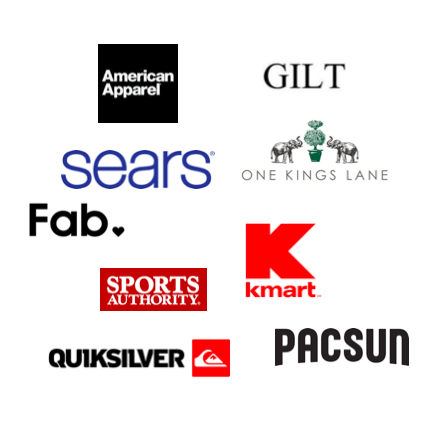
Cali Pitchel says of Everlane’s brand: “It’s uncomplicated and effective—and clear driver of success for the business.” Everlane’s brand is intentional, concise and clean.
The feeling I get when browsing Everlane.com is: clean and detailed. Everlane raises the curtain on its entire process, revealing the supply chain and costs for every garment they make.
Their attention to detail touches everything from their photography to product descriptions to “Everlane” branded source code.
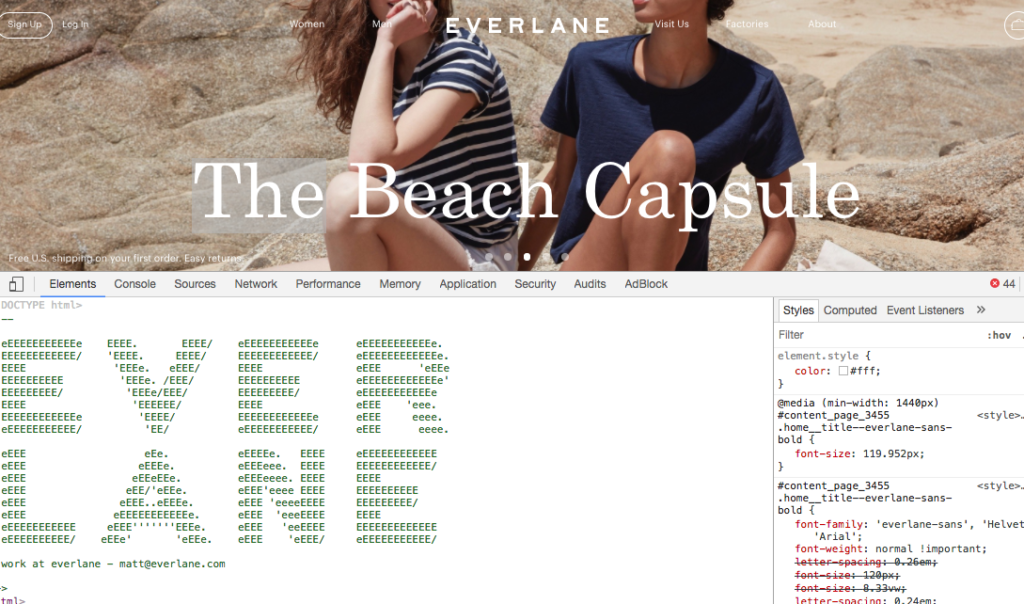
Everlane’s brand is engaging and memorable.
Look no further than Everlane’s super clean homepage for evidence of this brand-first focus. They reserve one of five hyperlinks in their header for “factories.”
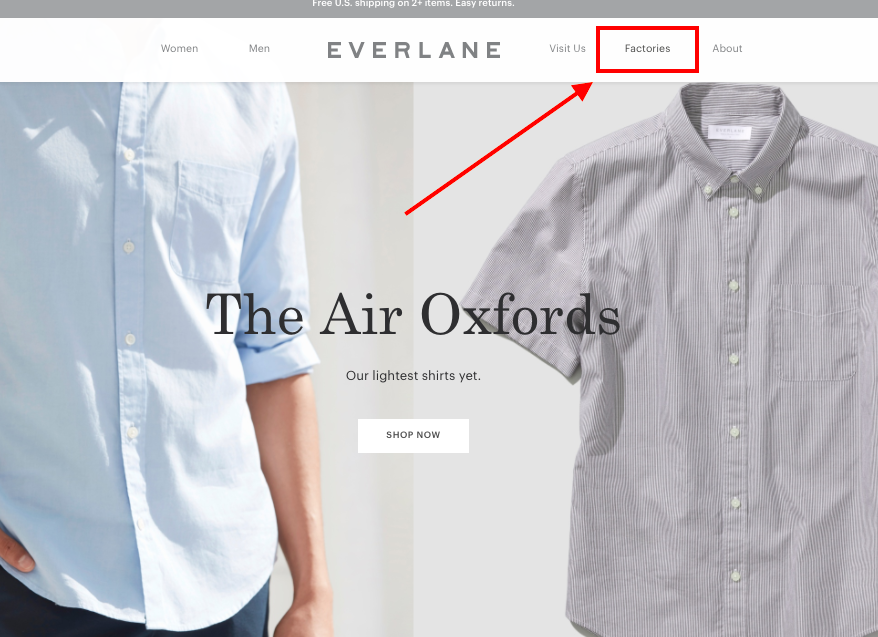
While they might be better served (from a customer acquisition perspective) to use this real estate to advertise their referral program, Instagram feed, bulk ordering or affiliate program, they choose to instead focus on brand where reasonable.
FYI: if you click the “factories” page you’re brought to an interactive map of their supply chain across hundreds of garments.
Read: How to Start a Fashion Blog
Read: How to Start an Ecommerce Store
4. Prelaunch Strategy
Everlane launched to an already-captive audience because of an email collection prelaunch strategy. They gave out tiered rewards to users for referring friends to the prelaunch, which dragged on for six months+. They created a little extra allure by creating six months of mystery.
Below is razor company, Harry’s prelaunch referral program. It’s not Everlane’s but you get the idea is the same – refer friends and earn products and rewards.
Read: The Best Digital Marketing Launch Strategies for more on this.
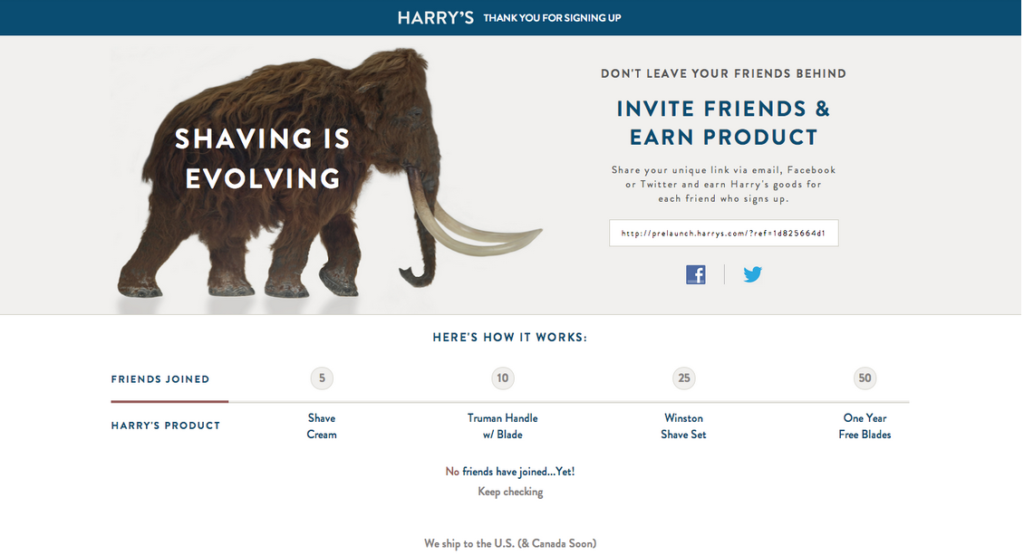
5. Referral Program
Referral programs end up being ~15% of revenue for many ecommerce companies. Today, referral programs are fairly common, but Everlane was a little ahead of its time for building a robust, account-based referral program.
Even today, their referral program sits at the bottom of every page of the logged-in website.
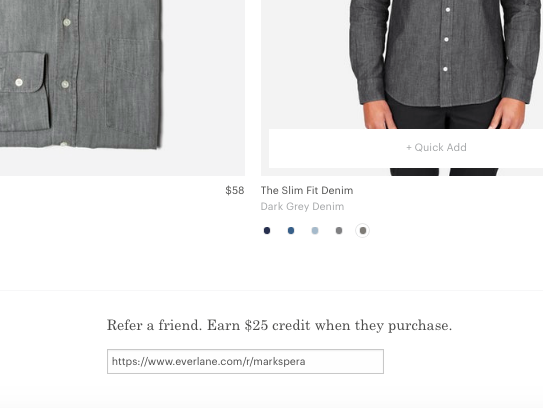
6. Tumblr
Believe it or not Tumblr deserves a big assist for helping Everlane get it’s first users. Everlane knew where its younger audience was congregating and had a really great infographic that was apparently worth sharing. Everlane continued to make quality infographics that were fun and shareable.
Their original infographic garnered 17,000 notes on Tumblr as of this 2012 article (full disclosure I’ve never used Tumblr- instead I always set up a WordPress blog).
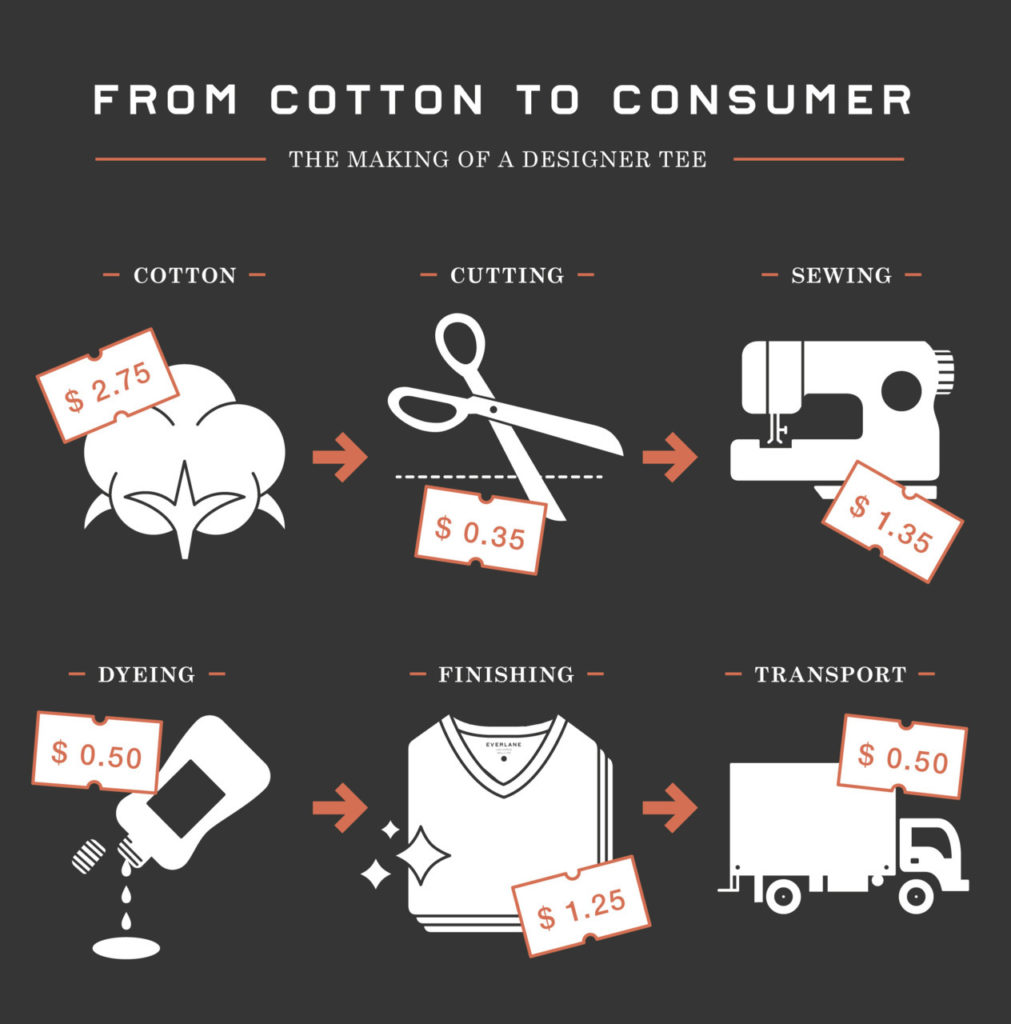
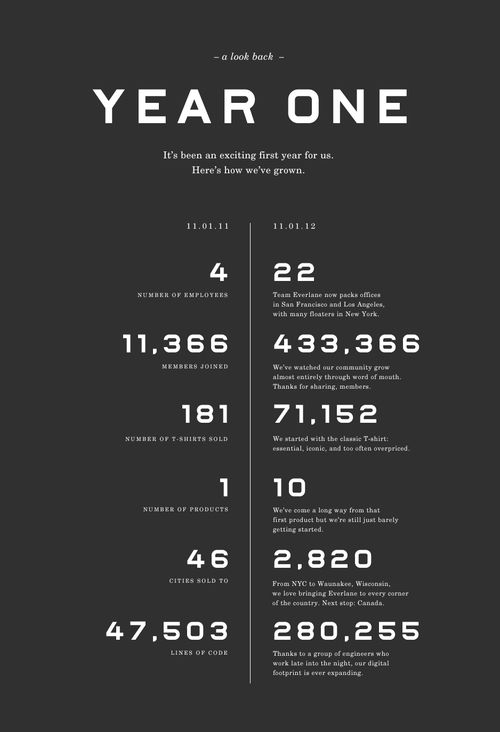
I don’t say this to imply that you should be using Tumblr as part of your acquisition strategy.
In fact, I’m pretty sure that you should not. The point is that you should sniff out any opportunity as a growth marketer, with a preference for ones that are at the intersection of what you’re good at and where your audience is.
7. Affiliate Marketing
Everlane has appeared on countless fashion blogs. Not all of those mentions are organic. Browse to the affiliates section of their website and voila: a robust affiliate program.
Affiliate marketing is an incredible way to reach more users. In exchange for a percent of sales, bloggers will review Everlane’s products and post their reviews. In this way, Everlane reaches a very wide audience across the interweb.
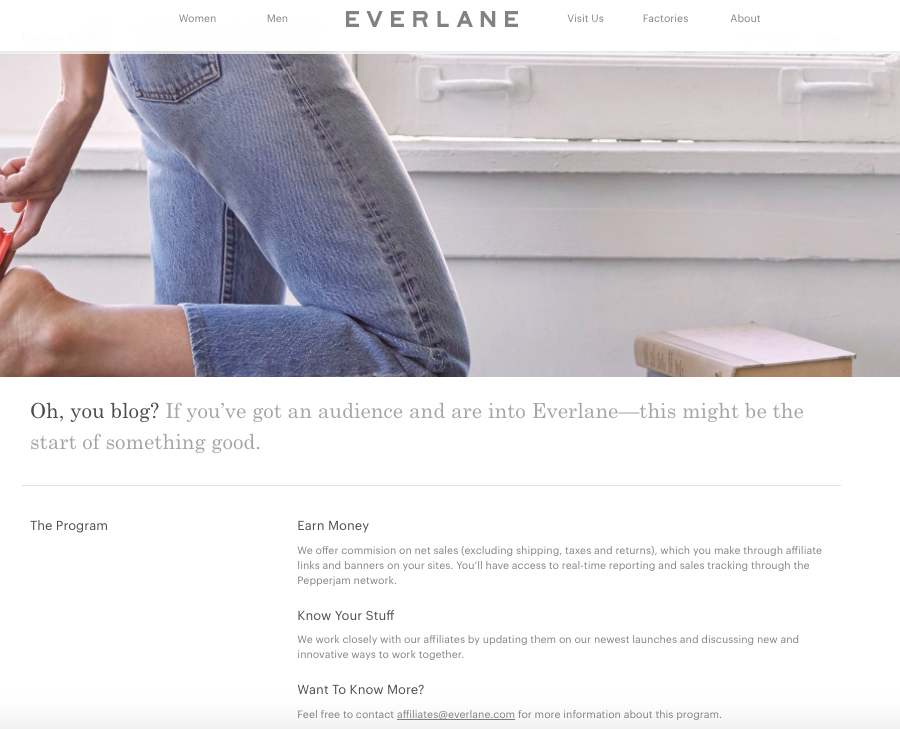
8. Guerilla Marketing
Guerilla marketing is doing anything that is disruptive, cheap and creative to acquire customers.
Everlane partnered with on-demand food delivery company, Postmates to deliver its clothing basics in under an hour in major cities across the U.S. To my knowledge, they were the first clothing company to deliver in under an hour.
Not only was that an appealing proposition to its existing customers – who are mostly city-dwelling 20-40somethings – the press liked the activation. Search for Everlane and Postmates on Google and you’ll get 4,520 results. Everlane took the opportunity to tell reporters in every city that Postmates delivers to.
FYI: I wrote a post about startup PR here.

9. Delighting Customers
“Build a great experience, customers tell each other about that. Word of mouth is very powerful.” — Jeff Bezos, CEO, Amazon.com
Some ecommerce companies are faceless, even lifeless. Everlane uses customer interaction as an opportunity to delight.
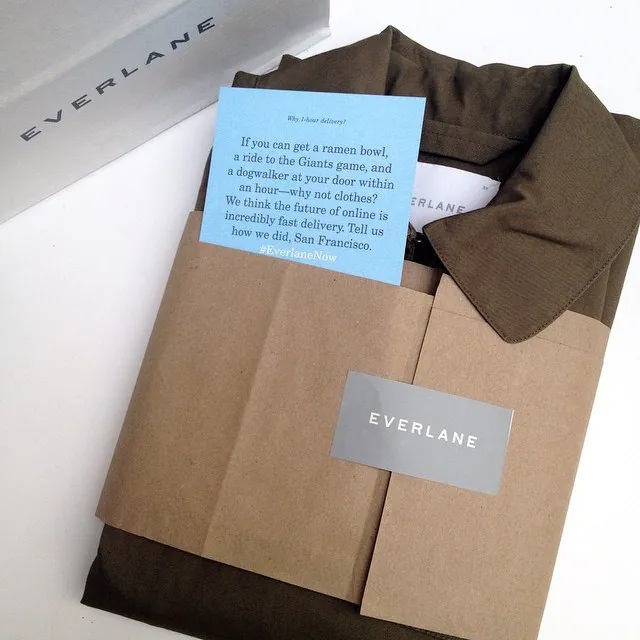
Everlane gets a lot of repeat purchasers. I own one or two pieces myself. But I personally know three or four superfans who have filled their wardrobe with Everlane pieces. Their huge revenue with only tens of millions in venture capital is proof of a very efficient marketing spend – I’d guess they have a very healthy repeat rate and customer LTV.
Everlane has done things like invite random customers for dinner and let customers tour their L.A. factories in groups.
It should go without saying that repeat purchases are the easiest sales startups can make. If you spend a little to delight your customers, you are more likely to make em’ smile and create a preference vector for you and your brand.
10. They Keep Pace with their Audience
Everlane tends to stay on top of the latest digital marketing strategies and trends. They stay current. Everlane’s Snapchat story is peppered with how-to’s, behind the scenes looks and a bit of personality. “I wake up with a full inbox of messages and questions,” Red Gaskell, Everlane’s social media manager says about Everlane’s Snapchat account.
Everlane hangs with its 20 and 30something audience by staying current. It’s no surprise, as Everlane’s office is full of 20 and 30somethings. More recently, Everlane began using Facebook Messenger (for a short time) to augment its existing customer service efforts.
Even more than keeping up with their demographic, brands that stay current often benefit from first-mover advantage in certain paid marketing channels.
Everlane was a fairly early user of Facebook advertising and benefited from lower cost inventory in the beta days of Facebook ads.
In Conclusion
Everlane has ridden its mastery of product and its mission all the way to a $250 million+ valuation.
To me, the takeaway from the Everlane ecommerce story is this: build your brand into your ecommerce acquisition strategy and your audience will pay you for it in the form of repeat purchases and by sharing with friends.
Learn more about growth by watching our growth movie here >>
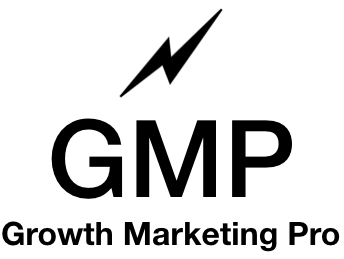



Amazing case study. Learned some marketing lessons. Really a good post.
A truly great blog, love the information you provided on startup success factors!